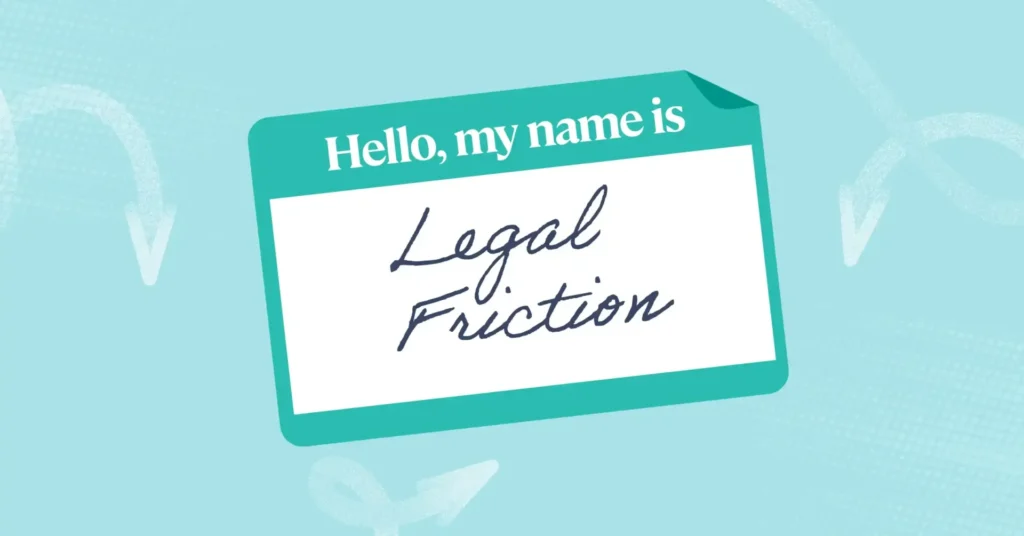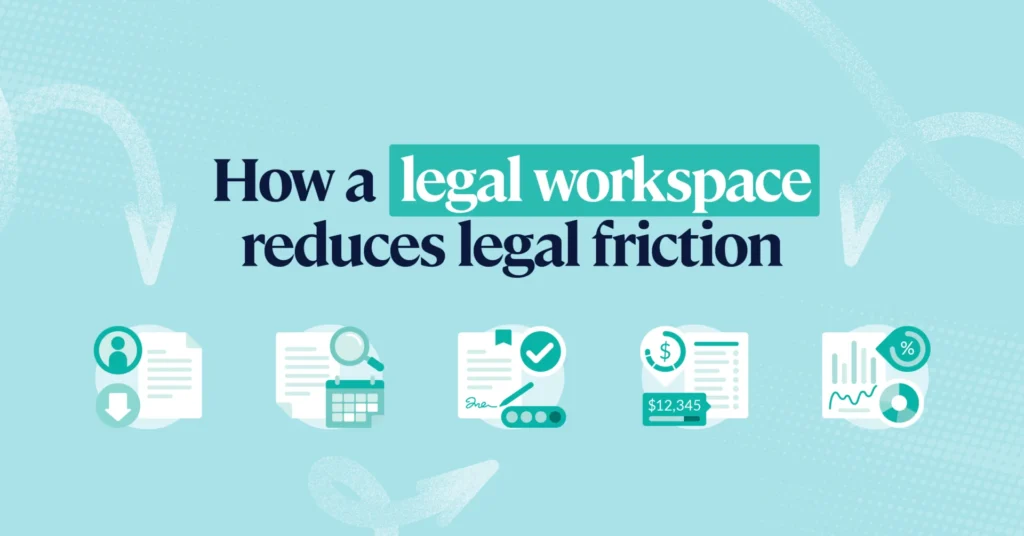Legal Friction: The problem you’ve felt as general counsel, finally named – and solvable

If you’re a general counsel in today’s world, you’ve likely felt it. That persistent drag on your legal team’s time. The constant pull between being a business partner and a backlog manager. The tension between legal and the business, despite everyone’s best intentions.
It’s not always easy to pinpoint – but it’s real.
It’s called legal friction. And for todays general counsel, understanding it isn’t just helpful – it’s mission-critical.
What is legal friction?
Legal friction is the operational drag that is created by inefficient legal processes and fragmented workflows within in-house legal functions, as well as between legal and business partners.
It’s the manual intake, the overwhelming volume of emails, the clunky workflows, the different systems that don’t talk to each other, and the time spent on manual tasks instead of strategy. It’s also the reputation hit when other business functions say, “legal slows us down,” and the difficulty of proving the value of legal as a result of limited data.
The latest research from IDC finally gives a name – and a number – to what general counsel have felt for years: historic underinvestment combined with growing workloads and increasing expectations creating legal friction. And it’s costing you more than just time.
Legal friction is eroding legal’s capacity, credibility, and ability to deliver the full business value your team is capable of. The research – conducted with both legal leaders and business leaders across the UK, US, and APAC – quantifies the impact of legal friction on both legal and the business with some staggering figures.
According to IDC’s white paper, The Hidden Cost of Legal Friction:
- Around 11 percent of revenue generation* has been lost or delayed in the past 12 months due to inefficient legal processes, representing an estimated USD $144 million for the average enterprise.
- Legal inefficiencies force enterprises to outsource approximately one-sixth (16.5 percent) of their legal work unnecessarily, incurring avoidable costs which equate to potential savings of USD $350,000 per organization.
- Inefficiencies lead to the equivalent of USD $300,000 in legal team time wasted annually that could be spent on higher-value, strategic work to maximize business outcomes.
- 73 percent of legal teams reported receiving customer complaints due to legal delays, and 70 percent of business leaders admitted bypassing internal legal processes altogether.
*For businesses surveyed with mean revenue of over USD $1 billion per annum
Why general counsel need to pay close attention to legal friction
Modern GCs aren’t just legal experts – they’re operators, strategists, and enterprise leaders. You’re expected to run legal like a business. You need ways to quantify and easily explain the business impact of the inefficient workflows and manual processes that hamper legal service delivery; without them, you may struggle to get the investment you need to solve the problem that legal friction poses.
The IDC research is a gift. It quantifies what’s been largely anecdotal: the operational drag, the reputational damage, and the cost of legal not being optimized to scale.
“Too often, legal functions remain under-resourced, lacking the modern ways of working and technology that their peer departments rely on to deliver value. Businesses need to understand that investing in legal workflows and data for continuous innovation supports overall organizational objectives” – IDC*
What the research says you can do about legal friction
The data in the IDC white paper doesn’t just offer a compelling basis for better investment in legal in the abstract.
Responses from legal teams and business leaders alike paint a clear picture of what is needed to meaningfully address the problem of legal friction – and IDC translates this feedback into three simple recommendations.
To combat legal friction head-on, IDC recommends that legal teams and their businesses embrace legal operations principles, streamline their legal workflows, and above all – adopt unified legal technology software.
The IDC data overwhelmingly signals the tangible impact experienced by businesses who have already implemented legal technology – and a strong appetite amongst those that are yet to adopt it:
- 71 percent of business leaders believe that in-house legal software is required to improve efficiency within their legal operations.
- 99 percent of legal teams believe that their existing investments in in-house legal software has improved their internal reputation across the business.
- On average, legal teams estimate a 13 percent saving on total legal spend as a result of cost and productivity gains from adopting legal technology software.
The IDC research offers a clear pathway to combatting legal friction through in-house legal technology, and it can be leveraged without placing any undue blame on your legal team.
But by owning the narrative, you can take proactive steps to lead the change that your function – and your wider business – needs.

From friction to force multiplier
With practical tips on evaluating and adopting legal tech. Hear from industry experts and learn how modern legal teams use tech to reduce friction and drive better business outcomes.
Three actionable takeaways for general counsel
1. Legal friction is the result of your team’s limited capacity – quantifying its impact is powerful
The research reveals that two thirds of business leaders believe revenue has been lost or delayed in the last 12 months due to inefficient legal processes. Legal team respondents agree, with 60 percent also saying that revenue has been lost or delayed as the result of legal inefficiencies.
Naturally, you’ll want to know what causes that inefficiency, so you can fix it. The research can help by showing how much of this opportunity cost is simply the result of in-house legal teams’ struggle for bandwidth as a result of inefficient workflows:
- 83 percent of legal teams believe that inefficient process or technology negatively impacts their ability to deliver legal services in a timely manner.
- 64 percent of legal respondents believe their teams waste time on tasks that business functions could handle themselves.
- IDC estimates that at least one day in each team member’s week is wasted on low-value tasks like searching emails, providing status updates, drafting or reviewing low risk routine contracts, and manually managing approval workflows.
All of this validates what many legal leaders already feel: growing workloads and inefficient, manual processes limit legal’s capacity, and that limited capacity negatively impacts financial and operational outcomes at a business level.
“Scattered communication, limited bandwidth, and insufficient data and technology contribute to legal friction.” – IDC*
Key takeaway: With data like this, you won’t need to spend time measuring your team’s overhead to make a case for legal technology to increase your team’s efficiency. Combine this data with tangible examples of ways limited bandwidth has impeded alignment with business objectives at your organization to make it more impactful when you present it.
2. The data about legal friction is your budget ammo – use it
It can feel uncomfortable to highlight inefficiencies, but remember: these results don’t just paint a concerning picture of the current state of enterprise legal teams, they pose an opportunity for businesses to find revenue and optimize operations through a better resourced legal function. On this front, the IDC research does the heavy lifting for you in two ways:
- It shows that legal’s challenges are systemic and common (not unique to you!) and;
- It offers a clear path to solving the problem through proven and attainable solutions.
Here are some of IDC statistics you can use to build your business case for better investment in your legal function:
- Fewer than 30 percent of the businesses reporting these negative outcomes have access to dedicated legal technology.Of those that do, 70 percent of legal teams report an increase in efficiency.
- Meanwhile, 90 percent of business leaders agree that the adoption of a unified legal tech solution has helped them better achieve business objectives.
- The research shows an estimated 13 percent of savings on total legal spend in cost and productivity gains from adopting legal technology solutions, and 11 percent of business revenue as part of your return on investment.
Key takeaway: Use this data to frame legal tech not as a cost, but as a strategic investment in efficiency, risk reduction, and business enablement. This legal friction calculator is a great tool to help you estimate the total savings your business could achieve and calculate the ROI of your recommended solution.
3. Ignoring legal friction builds operational debt, so act now
Just like technical debt in IT, operational debt in legal compounds over time. The more friction accumulates, the harder it becomes to scale, modernize, or attract top talent. General counsel who act now will not only reduce cost and stress – they’ll deliver more commercial value to the business and put their teams in a better position to act as strategic business partners over time. One easy way to understand the urgency is by calculating the cost of delay. At 13 percent of total legal spend, every month the average legal team* delays improving productivity represents a loss of USD $41,000 to the business.
*Based on median total spend figures taken from the ACC Law Department Benchmarking Report 2024.
And if the opportunity cost alone isn’t enough, the IDC research also offers plenty of evidence that investing in efficiency now is critical if businesses are to meet a growing demand for legal services in the future:
- Only 37 percent of legal teams are confident that they have adequate resources and staff to meet organizational demands at the present time.
- Increased breadth and complexity of work is listed as the top challenge faced by legal teams.
- 71 percent of business leaders indicate that technology investment is needed to scale and meet future growth demands.
Key takeaway: While evaluating solutions and engaging business stakeholders can feel like extra work for your busy team, there’s never been a better time to get started. There are a variety of free resources and tools available to help make the process faster without sacrificing quality outcomes – including business case templates, buyers guides and this C-suite guide to the value of legal technology.
Permission to lead
The legal friction you’re feeling? It’s not a reflection of your team’s effort. It’s a product of outdated systems and rising demands.
As general counsel, you don’t need to accept the status quo. You have the data, the insight, and the strategic leverage to make a change. Recognizing and resolving legal friction isn’t just an operational fix – it’s a leadership decision. And it’s one that sends a clear signal to your team and the business: legal is here to move faster, collaborate better, and lead with impact.
As IDC say, this research is “a stark reminder of how underinvested, under-resourced, and unprepared legal departments are to meet growing, increasingly complex business demands.”
Use this research to drive successful conversations with both your team and your organization. Backed by evidence, you’ll be in the strongest possible position to advocate for a better resourced legal function – ultimately unlocking greater operating efficiency and better outcomes across your business.
Click here to access and download your copy of the extensive IDC white paper now.
*Source: IDC White Paper, sponsored by LawVu, Legal Friction: The Real Cost to Your Business, #AP15041X, April 2025



